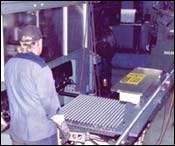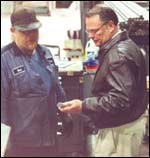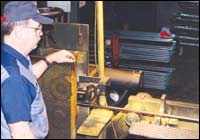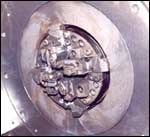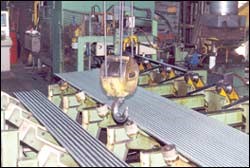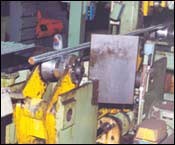Bar Processor Boosts Blank-Making Capabilities
This toll processor of steel bar is hustling to meet the growing demand for 'first operation' blanks.
Bar Processing Corp. (Flat Rock, Michigan) started up in the Detroit area in the early 1970s as a toll processor of hot rolled steel bar. The firm provides smooth-turned, pressure-polished, mill-length steel bar—commonly known as peeled bar—as an alternative to cold-drawn steel bar. Over the years, the company has enjoyed growing demand for its turned barstock. More recently, however, the firm has seen growing interest from its customers for cut-to-length blanks with varying levels of machining instead of full-length bars. To take advantage of what it sees as a growth market for its steel bar, the company is expanding blank-processing capabilities at its bar processing plants in Michigan, Illinois, Ohio and Indiana.
Bar Processing Corp. neither buys nor sells steel bar. It is a service provider that processes bar on a toll basis (on a price-per-pound basis) for its customers. The customers arrange for shipment of hot rolled bar from a steel mill to one or more of BPC’s facilities and also for the pickup of the processed bar.
The Bar Peeling Process
Like cold-drawn steel bar, peeled bar starts as hot rolled bar from a steel mill. The first operation performed on the hot rolled bar is straightening, up to 1/16 inch per 5 linear feet, in preparation for processing.
As it comes from the mill, hot rolled bar contains surface impurities and irregularities that BPC removes, or peels from the bar, in a machining operation. Bars are moved a bundle at a time via overhead crane from the straightener to a special turning machine called a bar peeler. At the peeler, the bars automatically feed one at a time through a rotating cutting head, which consists of four indexable carbide inserts spaced 90 degrees apart. The operator can adjust the speed of the cutting head from the machine’s control panel anywhere between 800 and 1,300 rpm. Bars are fed one at a time through the peeler at rates of 10 to 100 fpm, depending on such factors as size (diameter) and hardness.
BPC’s Newton Falls, Ohio, plant has several peelers varying in age and size capacity. A Kieserling machine processes smaller bar diameters, starting at 3/4 inch, while the plant’s newest machine, a $1.5 million, computer-controlled, Bultmann peeler, can accommodate bar up to 3 inches in diameter.
Getting Under The Skin
Peeling reduces the bar diameter by 4 to 10 percent (5 percent is the average). That ensures that 99.99 percent of objectionable surface conditions, such as seams and decarb, are removed, leaving a more consistent, more machinable bar.
Some of the bar’s straightness is lost in the peeling process, so after the bar is peeled, it goes to a burnishing operation for restraightening. There, the bar is passed between a pair of pressure polishing rolls that reduces the diameter of the bar from a few tenths to a few thousandths to achieve final size. As it emerges from the burnishing machine, the finished bar is within 0.003 inch of nominal diameter, with a 1/16 inch or better straightness per 5 feet and a 20 to 40 Ra surface finish.
From the burnishing operation, the bar is moved by crane to one of several nondestructive testing stations for inspection. Here, each bar undergoes eddy current testing for surface flaws such as seams, pits, cracks and tool marks. The stations can also ultrasonically test for interior flaws such as inclusions and interior cracks; however, testing of the bar interior is frequently omitted at the Newton Falls facility because the bar undergoes such tests at the mill.
According to Tim Scott, a NDT technician at the Newton Falls plant, about 90 percent of the bar processed at the facility undergoes NDT testing. “Our auto industry customers demand the tests,” he explains. “They cannot afford to waste time and energy machining and working material that is subsequently inspected and found to be defective. Then, too, our customers require complete documentation of the material’s integrity because of liability issues.”
Auto Part Applications
Jack Starkey, general manager of the Newton Falls facility, explains that BPC primarily serves automobile and truck manufacturers and their parts suppliers. Typical applications include long parts, parts with large diameters and parts made of harder alloys, he notes. Parts made from peeled bar are typically produced on turning equipment such as lathes and screw machines and on cold-forming presses.
Drivetrain and engine components are the company’s largest product applications. Engine components include crankshaft and camshaft blanks, valves, and injector nozzles for diesel engines. In the drivetrain area, the company provides barstock for CV joints, drive shafts, transmission shafts, and input and output shafts. In the steering area, the company has started supplying steering rack blanks, a major development that is described in detail a bit later.
“Over the years, the market for peeled bar has grown,” Mr. Starkey explains. “When BPC started up in the early ‘70s, cold drawn bar accounted for 85 to 90 percent of all cold finished bar consumed in the United States. Today, it’s more like 60-40.
“Most hot rolled steel bar from mills includes surface defects that cannot be ignored if the bar is to be used to make precision products,” he continues. “The surface defects must be machined away at some point in the manufacturing process so that they don’t compromise the manufacturing process or the performance or integrity of the end product.
“The advantage of peeled bar is that we remove those surface defects as part of our processing,” he continues. “By rough machining the steel in bar form, we eliminate the need for the customer to rough turn bars on a screw machine or rough turn blanks individually on chucking lathes. The customer does not have to worry about rough machining the material as a preliminary operation. As a result, the customer can order smaller-diameter bar, there are fewer chips, less tool wear, shorter cycle times, faster deliveries . . . Not having to rough machine can even free up a station or tool to enable a job to be completely machined in one setup.”
Mr. Starkey notes that sales of peeled bar have doubled during the last 5 years, and that 90 percent of that growth has been sales to Japanese automakers in this country and their U.S. suppliers. “The Japanese car companies and their suppliers are willing to pay a little more to ensure a high level of integrity in their incoming raw materials,” Mr. Starkey explains. “By buying peeled bar, they have reduced or eliminated downstream inspection and machining costs that, in many cases, our domestic automakers are still incurring.”
At the same time that sales of peeled bar increased, BPC also noted a trend among customers to purchase cut-to-length blanks instead of full-length bars. Fueling the trend to greater use of blanks was a desire by customers to reduce their bar handling and storage costs and to slough off less-essential operations that could be outsourced for less than the cost of doing them in-house. The trend created an opportunity for the company to offer its customers a greater range of products—specifically, more value-added products. Accordingly, the company began investing in more blanking equipment.
Adds Automated Blanking Line
An example of the shift to greater blank-making capability is a highly automated line for making blanks for steering racks that BPC recently installed at the Newton Falls facility. The line was built to supply blanks for a family of automotive steering racks to a major automotive parts manufacturer. The addition of the blanking line is such a logical extension of the plant’s core bar-making activities that it’s not hard to envision similar lines being added to the company’s other plants.
The steering rack blanking line consists of a carbide cutoff saw, a 4DE (double end) machine made by Bardons & Oliver Inc. (Solon, Ohio) that is capable of cutting off, chamfering and center-drilling both ends of a blank, and a Cincinnati centerless grinder. Bardons & Oliver also provided elements of the system that automatically conveys the bar from the saw, to and through the double-end machine, and to the centerless grinder.
Hot-rolled bar, straightened, peeled and burnished on the plant’s upstream equipment, is delivered via overhead crane to the inclined table of the carbide saw. The bars are automatically fed one at a time into the saw, which cuts them into 35-inch blanks.
From the saw, the blanks are conveyed a few feet to the double-end machine, which chamfers both ends of the blank. (The double-end machine can also face and center drill both ends of the blank, a capability that the Newton Falls plant expects to use for other blanks processed on the line.)
From the cutoff and chamfering machine, the chamfered blanks are automatically conveyed to a centerless grinder that grinds them to finish diameter (0.0008-inch tolerance) and a 12 to 14 Ra surface finish. The ground blanks are automatically discharged from the grinder to a table, where they are loaded by hand into shipping racks. The steering rack line is capable of producing 120 to 165 pieces per hour, depending on the length of the blank.
To accommodate customers who require more extensively machined blanks, the Newton Falls facility also added a battery of CNC lathes, equipped with bar feeders, to expand its turning capabilities. On the day of our visit, two machines in a cell were being used to center-drill both ends of transmission shafts. The addition of the CNC machines provides customers with one-stop-shopping capability, enabling them to buy peeled or peeled and burnished full-length bars for screw machining applications or cut-to-length blanks machined as extensively as they want. Instead of investing in additional plant space and equipment to respond to increases in demand, manufacturers and contract machining firms can shift basic machining operations to the Newton Falls facility, opening up capacity on existing equipment to handle unexpected demands on production.
According to Mr. Starkey, 75 percent of BPC’s capital spending in the coming years will go for equipment for producing “first-operation blanks,” or blanks that are ready to go right into production machines without any preliminary machining to remove surface flaws.
Read Next
5 Aspects of PMTS I Appreciate
The three-day edition of the 2025 Precision Machining Technology Show kicks off at the start of April. I’ll be there, and here are some reasons why.
Read MoreA Tooling Workshop Worth a Visit
Marubeni Citizen-Cincom’s tooling and accessory workshop offers a chance to learn more about ancillary devices that can boost machining efficiency and capability.
Read MoreDo You Have Single Points of Failure?
Plans need to be in place before a catastrophic event occurs.
Read More




